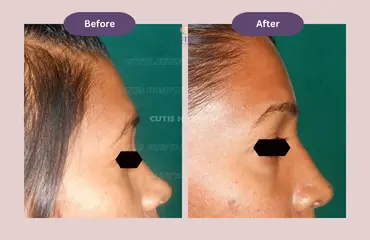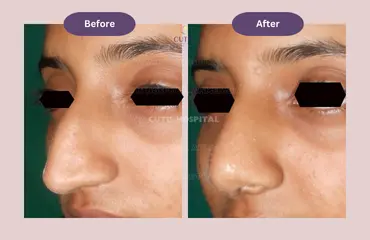A septoplasty is a surgical procedure used to relieve nasal blockages. A doctor may propose this procedure to repair a deviated septum, long-term sinusitis, nasal polyps, and other nasal airway obstructions. Surgeons sometimes suggest septoplasty as a way to address recurring nosebleeds.
Septoplasty is a simple, low-risk operation. Recovery often takes a few days and requires an average of one week of downtime. However, there are hazards associated with septoplasty, just like with any surgery: bleeding, infection, and numbness.
Septoplasty surgery involves reshaping a deviated nasal septum, which is the cartilage and bone that splits the inside of your nose into two nasal passages.
The nasal septum is positioned to one side of the nose when it is deviated. While some people are born with it, most cases of this are the result of trauma of some type.
A crooked septum may restrict or block airflow in one nasal tube, resulting in symptoms such as difficulty breathing, snoring, obstructive sleep apnea, regular nosebleeds, facial pain, and migraines. Additionally, it may increase your risk of sinus infections.
This surgical treatment straightens the septum, allowing for easier breathing through the nasal airway. Many people with septal deviation prefer to alleviate their symptoms using decongestants and nasal steroid sprays.
This kind of sinus surgery is frequently advised if symptoms continue and start to interfere with a person's everyday life.
Here are some of the common symptoms of a deviated septum:
A doctor and nurse will discuss the specifics with the patient before the surgery and they will ask that the patient undergo some common diagnostic tests, such as an X-ray, blood test, or electrical heart trace. They will also ask about general well-being, allergies, and current medications.
It is common practice to do septoplasty under general anesthesia. The patient will usually be asked to stop taking any oral blood thinners for at least one week before surgery to reduce the risk of bleeding.
The surgeon wants to straighten the misaligned cartilage and bone of the septum during a septoplasty treatment. First, the mucosa covering the cartilage and bone is lifted. After that, the surgeon forms the cartilage and bone, sometimes removing portions of it.
Following this, the liner will be replaced. If enlarged turbinates are producing a blockage, the surgeon may attempt to decrease them using radiofrequency reduction. In certain additional situations, the turbinate will be partially removed by the surgeon.
Based on the severity of the issue, a septoplasty might take anywhere from 30 to 90 minutes to perform. Depending on what you and your doctor determine is best for you, you will be given local or general anesthetic.
To gain access to the septum, the surgeon typically creates an incision on one side of the nose. They then lift the mucous membrane, which serves as the septum's protective covering. After that, the crooked septum is positioned correctly. All obstacles, like excess cartilage or bone, are eliminated. The last step is to realign the mucous membrane.
You may require stitches to keep the septum and membrane in place. However, just filling the nose with cotton can occasionally keep them in place.
Cutis Hospital is a renowned hospital offering top-notch septoplasty surgery treatment. Here are some of the reasons why you should go to Cutis Hospital to get the best septoplasty surgery:
Top Healthcare Professionals: Our skilled team comprises experienced surgeons and specialists, ensuring expert care and personalized attention with us throughout your septoplasty surgery process.
Post-Operative Support: Beyond surgical intervention, our commitment extends to comprehensive post-operative support. Our healthcare professionals guide you through recovery, ensuring optimal healing and long-term success.
Individualized Treatment Plans: Recognizing each patient's unique needs, we provide best-in-class, personalized treatment services. Our septoplasty surgery treatment is tailored to address specific problems, ensuring the best outcomes.
State-of-the-Art Facilities: Cutis Hospital is equipped with modern and advanced facilities, including cutting-edge technology for diagnosing nasal-related problems and surgical procedures.
Discover lasting relief with the best-in-class septoplasty treatment from Cutis Hospital.
Book your appointment today!



To reduce the likelihood of bleeding and edema, your surgeon might tell you to take some precautions for a few weeks. The following may not all be necessary for you to undertake, depending on the scope of your surgery:
Pros
Cons
You should consult with a facial plastic surgeon, a plastic surgeon with expertise in nasal surgery, or a board-certified ENT (ear, nose, and throat) specialist. The majority of insurance policies support septoplasty because they deem it medically necessary.
However, Dr. Cain points out that “insurance policies vary in the amount of co-pays, deductibles, and out-of-pocket expenses that you might still be accountable for.”
Doctors recommend requesting a referral from your primary care physician and verifying with your insurance provider to determine which surgeons or practices are covered by your plan.
Despite being an outpatient treatment, septoplasty recovery can still be difficult. After surgery, take early action to relieve discomfort and swelling by following your doctor’s instructions.
While recovering from a septoplasty, if you encounter any of the following, contact your healthcare physician or get emergency medical attention:
You should anticipate mild to severe discomfort after a septoplasty. Many describe the discomfort and pressure around the eyes, over the forehead, across the cheeks, and the upper teeth as being similar to a sinus infection. These are common side effects that go away in a few days.
No. Septoplasty itself does not alter the shape of your nose. However, your surgeon might be able to perform septoplasty with rhinoplasty if you would like to modify the form of your nose in addition to having your deviated septum corrected. To learn more, consult your healthcare practitioner about your treatment choices.
Cutis Hospital is conveniently located in Ghatlodia, Ahmedabad, making it easily accessible via multiple modes of transportation. Below are the various ways you can reach our facility:
Sardar Vallabhbhai Patel International Airport: Located approximately 12.7 km from Cutis Hospital, offering convenient access for patients traveling from outside the city.
Chandlodiya Railway Station: Approximately 2.4 km from Cutis Hospital.
Ahmedabad Railway Station: Around 11 km from our center.
GSRTC:
Ahmedabad Central Bus Station (GSRTC): About 10.3 km from the hospital.
AMTS:
Bhuyangdev Cross Road Bus Stop: Just 500 meters from Cutis Hospital.
BRTS:
Bhuyangdev BRTS Bus Stop: Only 170 meters from our center.
We provide effective surgical and non-surgical treatments for all parts of the body. At Cutis Hospital, our cosmetic and plastic surgery team is committed to giving patients safe and high-quality care.